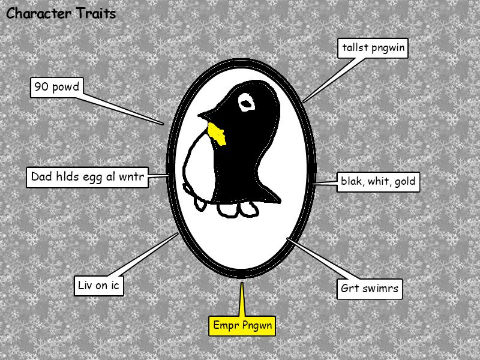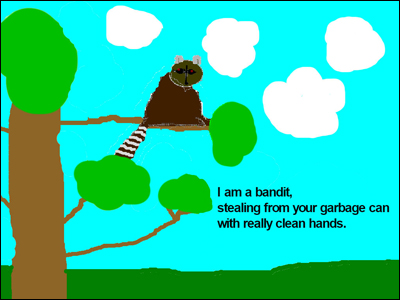
Students will research an animal and create a riddle to showcase their knowledge and engage other students in the natural world.

Kids love jokes and riddles! Your class will create a series of riddles that other students can use to learn about animals.
In this lesson, students will complete research about an animal and demonstrate their knowledge about the animal by creating a riddle they present to challenge other student's knowledge.
Introduce your students to animal riddles by reading ABC Animal Riddles (rhyming verse) by Susan Joyce or If Not for the Cat (haiku) by Jack Prelutsky. These books will engage your students in the process and demonstrate various ways that riddles can be written.
Discuss the riddles you have read with your students. You might ask:
Let your students know that they will be creating their own animal riddles. Each student will choose an animal and create two pages in Wixie for the riddle.
Page 1 will be the riddle. An example might look like this:
Page 2 will be an illustration of the animal.
Brainstorm a list of different animals with the entire class. Depending on your current science focus, you may want to narrow your brainstorm to types of animals, such as mammals, or animals that live in a particular habitat like the desert.
Students should choose one animal from the list and write down what they already know about the animal using a cluster, character trait map, or other graphic organizer.

Create a Graphic Organizer
Need a thought web, timeline, flowchart, or other graphic organizer for a lesson?
CreateIn order to formulate the riddle, students will write clues based on the following questions:
Give students time in the library or online to research the answers to these questions. Students should add their research notes to their existing cluster organizer.
When their research is complete, students should write a draft of the riddle. Students can write their riddle a number of ways. For example, the riddle could contain four sentences that explain:
The riddle could also take the form of a haiku!
Students can use a tool like Wixie to create their riddle pages. Use the Text tool to add the text of the riddle to page 1. Use the paint tools or image button to illustrate the animal.
Students can record their voice reading the riddle on page 1 and add illustrations or images that support the words in the riddle.
Students can print their project as a table tent or greeting card. Combine individual student pages together using Wixie's Project Wizard feature.
Celebrate and present the student riddles! If students printed table tents or greeting cards, have them place the printed projects on their desks. Encourage students move around the room to read and guess at other students’ riddles.
If you choose to combine student work into one large file, use the Show button to share it with your class. Have each student take control of their work to read their riddle and facilitate class discussion and guesses. You might even want your class to present the riddles to students in another class.

In the beginning stages, the cluster map organizer can be used to assess each student’s prior knowledge. You can continue to monitor progress as students complete and add their research notes and write their riddles. As students begin illustrating, prompt them with questions about their animals to encourage them to add more details and create more complete and specific illustrations.
Joyce, Susan. ABC Animal Riddles, ISBN: 0939217511
Yolen, Jane. Least Things: Poems About Small Creatures, ISBN: 1590780981
Prelutsky, Jack. If Not for the Cat, ISBN: 0060596775
Grade 2 LS4-1 Biological Evolution: Unity and Diversity
Make observations of plants and animals to compare the diversity of life in different habitats.
Grade 3 LS3-1 Heredity: Inheritance and Variation of Traits
Analyze and interpret data to provide evidence that plants and animals have traits inherited from parents and that variation of these traits exists in a group of similar organisms.
Reading Theme
Key Ideas and Details
1. Read closely to determine what the text says explicitly and to make logical inferences from it; cite specific textual evidence when writing or speaking to support conclusions drawn from the text.
Craft and Structure
4. Interpret words and phrases as they are used in a text, including determining technical, connotative, and figurative meanings, and analyze how specific word choices shape meaning or tone.
5. Analyze the structure of texts, including how specific sentences, paragraphs, and larger portions of the text (e.g., a section, chapter, scene, or stanza) relate to each other and the whole.
6. Assess how point of view or purpose shapes the content and style of a text.
Integration of Knowledge and Ideas
8. Delineate and evaluate the argument and specific claims in a text, including the validity of the reasoning as well as the relevance and sufficiency of the evidence
9. Analyze how two or more texts address similar themes or topics in order to build knowledge or to compare the approaches the authors take.
Writing Theme
Text Type and Purpose
2. Write informative/explanatory texts to examine and convey complex ideas and information clearly and accurately through the effective selection, organization, and analysis of content.
Production and Distribution of Writing
4. Produce clear and coherent writing in which the development, organization, and style are appropriate to task, purpose, and audience.
Research to Build Present Knowledge
7. Conduct short as well as more sustained research projects based on focused questions, demonstrating understanding of the subject under investigation.
9. Draw evidence from literary or informational texts to support analysis, reflection, and research.
Range of Writing
10. Write routinely over extended time frames (time for research, reflection, and revision) and shorter time frames (a single sitting or a day or two) for a range of tasks, purposes, and audiences
Speaking and Listening Theme
Comprehension and Collaboration
2. Integrate and evaluate information presented in diverse media and formats, including visually, quantitatively, and orally.
3. Evaluate a speaker's point of view, reasoning, and use of evidence and rhetoric.
Presentation of Knowledge and Ideas
4. Present information, findings, and supporting evidence such that listeners can follow the line of reasoning and the organization, development, and style are appropriate to task, purpose, and audience.
Language Theme
Conventions of Standard English
1. Demonstrate command of the conventions of standard English grammar and usage when writing or speaking
Knowledge of Language
3. Apply knowledge of language to understand how language functions in different contexts, to make effective choices for meaning or style, and to comprehend more fully when reading or listening.
3. Knowledge Constructor
Students critically curate a variety of resources using digital tools to construct knowledge, produce creative artifacts and make meaningful learning experiences for themselves and others. Students:
a. plan and employ effective research strategies to locate information and other resources for their intellectual or creative pursuits.
b. evaluate the accuracy, perspective, credibility and relevance of information, media, data or other resources.
c. curate information from digital resources using a variety of tools and methods to create collections of artifacts that demonstrate meaningful connections or conclusions.
6. Creative Communicator
Students communicate clearly and express themselves creatively for a variety of purposes using the platforms, tools, styles, formats and digital media appropriate to their goals. Students:
a. choose the appropriate platforms and tools for meeting the desired objectives of their creation or communication.
b. create original works or responsibly repurpose or remix digital resources into new creations.
c. communicate complex ideas clearly and effectively by creating or using a variety of digital objects such as visualizations, models or simulations.
d. publish or present content that customizes the message and medium for their intended audiences.

Follow us on Instagram for daily inspiration

Create a thought web, cluster, flowchart, or other graphic organizer for a lesson
Five ideas for creative classroom centers
Creative, digital book reviews
Fun and powerful ideas with animated characters

Wixie
Share your ideas, imagination, and understanding through writing, art, voice, and video.

Rubric Maker
Create custom rubrics for your classroom.

Pics4Learning
A curated, copyright-friendly image library that is safe and free for education.

Wriddle
Write, record, and illustrate a sentence.

Get creative classroom ideas delivered straight to your inbox once a month.
Topics